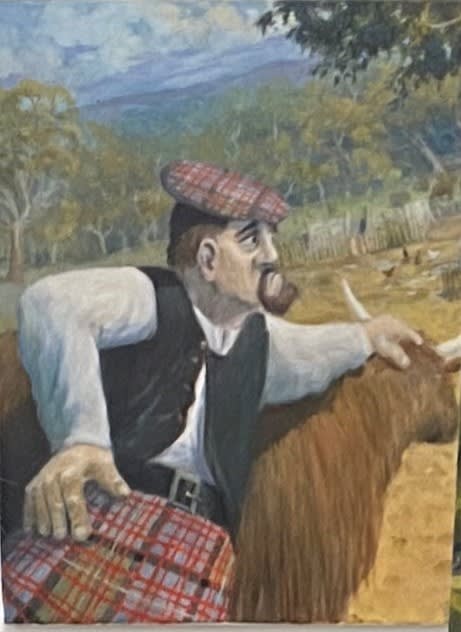THE CFA radio chirps away in the background occasionally interrupting Port Albert artist, one time fire brigade captain, Warren Curry, as he explains the heritage of some of his paintings.
The studio at the rear of his historic shop and residence is what you’d expect, a room filled with recent and older works, some on the walls, others leaning against the wall or tables, and an easel with his latest painting, almost complete, of a Murray River paddle steamer.
There’s a pallet daubed with a riot of colours, mixed and ready to be applied with expert strokes.
“That’s Pretty Boy Healey,” says Warren of an especially heinous scene of a man with a menacing face, dressed in a fetching red shirt, having just finished stabbing a hapless individual for a fistful of money. His dog too. There’s a bloodied knife in his other hand, the victim fallen with red paint splashed across his white shirt.
“Apparently his mate had a win at the races and wasn’t prepared to share the proceeds,” he said.
“They were pretty wild times here in the 1840s and 1850s.
“The story goes that a couple of other people might also have been involved which is why there’s the suggestion of others in the picture.”
In fact, John ("Pretty Boy") Healey was hanged at the Melbourne Gaol on November 29, 1847 for the murder of Jemmy Ritchie at Tarraville, not much more than a few kilometres away from Warren’s gallery, at 69 Tarraville Road, Port Albert.

There’s also the story of the Scottish Laird of Glengarry,, Aenes Ronaldson Macdonell, who sold up everything in his native land and moved to the ‘land of opportunity’, landing at Port Albert in July 1841 to set up a dairy farm localy for the new colony. He brought a herd with him and even a house to be reassembled but he underestimated the climate. Where milk could easily be transported in his native Scotland without spoiling such was not the case in Gippsland. The venture failed, he went broke, and went home. There’s now a painting by Warren Curry which tells the story.
He knows a lot about the history of the Yarram district, from a lifetime living locally, from his own interest in the people and places, and also after painting hundreds of works of historic events, buildings and places of interest.
Recently, a difficult but respectfully rendered scene of the Warrigal Creek massacre was sold, part of a series on the history of the district, and no doubt with a story by Warren to go with it.
In July 1843, a man named Ronald Macalister was killed by Aboriginal men near Port Albert, allegedly following the rape of an aboriginal woman. The Scottish colonist and pastoralist, Angus McMillan, led a group of around 20 colonists against the Aboriginal people they believed responsible, across a number of days including an attack on the Brataualung people camped at Warrigal Creek, one of several incidents resulting in loss of life among the Gunai Kurnai people of the area.
Historical accounts vary from between 60 and 150 being killed.
Not to excuse what is the region’s most notorious incident, Mr Curry notes the general lawlessness of the time.
In fact, the incident may well have brought about change.
When Port Albert was first settled it was part of the Sydney district of the colony and there was no supervision of the area until September 1843 when Gippsland became a district of Port Phillip and was the responsibility of the Commissioner of Crown Lands. Charles James Tyers was appointed as the first Crown Lands Commissioner for Gippsland. He arrived at Port Albert early in 1844 and set about bringing law and order to the Port which up to this time had been lawless with reports of smuggling, sly grogging, robberies, physical attacks and murder. In January 1844, Captain William Moore was appointed Collector of Customs and David Fermaner, who had acted as pilot was officially appointed to this office on January 31, 1845. In 1846 the Port acquired a landing waiter and a tide surveyor.
There are paintings of Charles James Tyers arriving at the Port and also of Captain Moore in front of the old Customs House, long gone.
But there are happy scenes too of Pelekas on the Greek Island of Corfu where Warren takes an annual painting and travel tour.
Also some of his traditional works of local farmhouses, hotels and interesting buildings, although most of these are painted on commission, and of course streetscapes and coastal scenes from in and around his beloved Port Albert, including some of its famous ship wrecks.
The paintings are great, but like the provenance of a special wine, the stories that go with them are just as good.
Born in Yarram he studied painting and sculpture at the City and Guilds School of Art London, and drawing at the Byam Shaw Art School, London.
His gallery is located at 69 Tarraville Road, Port Albert but as it is open at irregular times, it’s best to arrange a visit by e-mail on currystudios@netspace.net.au or phone (03) 5183 2588. Website at http://warrencurry.com/











